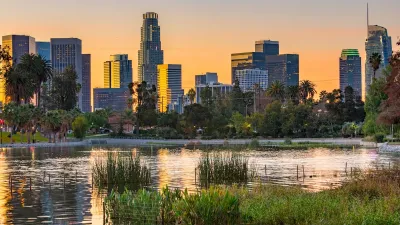L.A. Times architecture critic Christopher Hawthorne and transportation reporter Steve Hymon look at a proposal to raise the sales tax in L.A. to fund public transit. They call it a good opportunity for the city's urbanism, but also a tough sell.
Hawthorne writes:
"On Tuesday, voters in L.A. County will decide the fate of Measure R, which proposes raising the sales tax by a half-penny to pay for new subway and light-rail lines, along with some roadway improvements. (In all, 65% of its proceeds, pegged at roughly $40 billion over 30 years, would go to public transit.) It faces an uphill battle, primarily because it requires two-thirds approval to pass but also because it has divided politicians around the county. Those on the Westside, which would benefit most directly from Measure R dollars -- particularly for a subway extension along or near Wilshire Boulevard -- tend to favor it. Those in areas set to receive less funding, including Long Beach and Pasadena, have strongly opposed it."
"From a political as well as fiscal point of view, to be sure, the measure might have been more stragetically written. Still, its implications for urbanism -- beyond the question of how to move people around the city and get them out of their cars -- have not received nearly enough attention."
"Measure R is an effort to help subsidize a transition in L.A. back to an earlier model of public-transit mobility and perhaps a return to a broader, more comprehensive urban universe as well."
Hymon looks at some of the details of the bill, and answers some of the questions it raises:
"Would Measure R raise enough money to finish all the projects it proposes to build?
Probably not. Most of the projects will need more money to be completed. The list of Measure R projects is long because it was designed to secure political support by offering something for many constituencies.
It also should be noted that many of the projects, such as the subway, have yet to receive environmental clearances that would allow them to start construction.
So how far does $4.1 billion get the subway?
The MTA says that could be enough to extend the line from its terminus at Wilshire Boulevard and Western Avenue to Westwood. The route hasn't been decided, but a recent MTA study recommended that the subway follow Wilshire to Beverly Hills, swing south to Century City and then north to Westwood."
FULL STORY: Measure R is more than roads and rails

Manufactured Crisis: Losing the Nation’s Largest Source of Unsubsidized Affordable Housing
Manufactured housing communities have long been an affordable housing option for millions of people living in the U.S., but that affordability is disappearing rapidly. How did we get here?

Americans May Be Stuck — But Why?
Americans are moving a lot less than they once did, and that is a problem. While Yoni Applebaum, in his highly-publicized article Stuck, gets the reasons badly wrong, it's still important to ask: why are we moving so much less than before?

Research Shows More Roads = More Driving
A national study shows, once again, that increasing road supply induces additional vehicle travel, particularly over the long run.

Judge Halts Enforcement of Anti-Homeless Laws in Grants Pass
The Oregon city will be barred from enforcing two ordinances that prosecute unhoused residents until it increases capacity and accessibility at designated camping sites.

Advancing Sustainability in Los Angeles County Schools
The Los Angeles County Office of Education’s Green Schools Symposium brings together educators, students, and experts to advance sustainability in schools through innovative design, climate resilience strategies, and collaborative learning.

Using Old Oil and Gas Wells for Green Energy Storage
Penn State researchers have found that repurposing abandoned oil and gas wells for geothermal-assisted compressed-air energy storage can boost efficiency, reduce environmental risks, and support clean energy and job transitions.
Urban Design for Planners 1: Software Tools
This six-course series explores essential urban design concepts using open source software and equips planners with the tools they need to participate fully in the urban design process.
Planning for Universal Design
Learn the tools for implementing Universal Design in planning regulations.
City of Moreno Valley
Institute for Housing and Urban Development Studies (IHS)
City of Grandview
Harvard GSD Executive Education
NYU Wagner Graduate School of Public Service
City of Cambridge, Maryland
Newport County Development Council: Connect Greater Newport





























